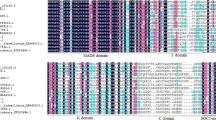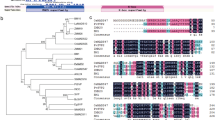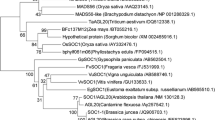Abstract
A complex and intricate network of genes responding to various developmental and environmental signals control floral transition in plants. MADS-box genes are the key regulators and major contributors with regard to flowering time determination. Previously, MPF2-like genes belonging to the STMADS11 superclade were duplicated into MPF2-like-A and MPF2-like-B in Withania (WSA206 and WSB206) and Tubocapsicum (TAB 201). The present study was conducted to determine the effect of MPF2-like genes on flowering time by analyzing 35S:MPF2-like transgenic Arabidopsis plants as well as to probe their effects on the expression of SUPPRESSOR OF OVEREXPRESSION OF CONSTANS 1 (SOC1, a floral promoter) and MADS AFFECTING FLOWERING 1 (MAF1, a floral repressor) genes. The overexpression of WSA206 (35S:MPF2-like-A) moderately promoted flowering, while that of WSB206 and TAB 201 (35S:MPF2-like-B) exhibited no effects on floral transition. Concomitantly, an elevation in SOC1 transcript abundance and a reduction for MAF1 transcript levels were observed in 35S:WSA206 transgenic plants. Nucleotide diversity analysis indicated an extraordinary 8 aa extension at the C-terminus of the WSA206 protein. Ectopic expression of a truncated WSA206-version without these 8 aa (WSA206ΔC246) and of MPF2-like-B-versions elongated by these 8 aa (WSB206∇C257 and TAB 201∇C257) in Arabidopsis revealed an ambiguous role of the 8 aa signature in floral transition. It may influence a protein’s ability to modulate flowering time but is neither sufficient nor strictly necessary for early flowering. Nevertheless, the 8 aa extension influences the expression of SOC1 and MAF1 in MPF2-like derivative constructs. Our studies provide insight into the role of MPF2-like genes in phase transition by interacting with SOC1 and MAF1 genes, thereby also pointing to their significance as potential candidates for modifying flowering in crop plants in the future.






Similar content being viewed by others
References
Liu, C., Chen, H., Er, H. L., Soo, H. M., Kumar, P. P., Han, J. H., et al. (2008). Direct interaction of AGL24 and SOC1 integrates flowering signals in Arabidopsis. Development, 135, 1481–1491.
Amasino, R. (2004). Vernalization, competence, and the epigenetic memory of winter. Plant Cell, 16, 2553–2559.
Balasubramanian, S., Sureshkumar, S., Lempe, J., & Weigel, D. (2006). Potent induction of Arabidopsis thaliana flowering by elevated growth temperature. PLoS Genetics, 2(7), e106. doi:10.1371/journal.pgen.0020106.
Blazquez, M. A., Ahn, J. H., & Weigel, D. (2003). A thermosensory pathway controlling flowering time in Arabidopsis thaliana. Nature Genetics, 33, 168–171.
Cerdan, P. D., & Chory, J. (2003). Regulation of flowering time by light quality. Nature, 423, 881–885.
Halliday, K. J., Salter, M. G., Thingnaes, E., & Whitelam, G. C. (2003). Phytochrome control of flowering is temperature sensitive and correlates with expression of the floral integrator FT. Plant Journal, 33, 875–885.
Boss, P. K., Bastow, R. M., Mylne, J. S., & Dean, C. (2004). Multiple pathways in the decision to flower: enabling, promoting, and resetting. Plant Cell, 16, 18–31.
Parcy, F. (2005). Flowering: a time for integration. International Journal of Developmental Biology, 49, 585–593.
Simpson, G. G., & Dean, C. (2002). Arabidopsis, the Rosetta stone of flowering time? Science, 296, 285–289.
Shore, P., & Sharrocks, A. D. (1995). The MADS-box family of transcription factors. European Journal of Biochemistry, 229, 1–13.
Theißen, G., & Saedler, H. (1995). MADS-box genes in plant ontogeny and phylogeny: Haeckel’s ‘biogenetic law’ revisited. Current Opinion in Genetics & Development, 5, 628–639.
Riechmann, J. L., & Meyerowitz, E. M. (1997). MADS domain proteins in plant development. Biological Chemistry, 378, 1079–1101.
Theissen, G., Becker, A. D., Rosa, A., Kanno, A., Kim, J. T., Münster, T., et al. (2000). A short history of MADS-box genes in plants. Plant Molecular Biology, 42, 115–149.
Ng, M., & Yanofsky, M. F. (2001). Function and evolution of the plant MADS-box gene family. Nature Reviews Genetics, 2, 186–195.
Theissen, G. (2001). Development of floral organ identity: stories from the MADS house. Current Opinion in Plant Biology, 4, 75–85.
Schwarz-Sommer, Z., Huijser, P., Nacken, W., Saedler, H., & Sommer, H. (1990). Genetic control of flower development by homeotic genes in Antirrhinum majus. Science, 250, 931–936.
Michaels, S. D., & Amasino, R. M. (1999). Flowering locus C encodes a novel MADS domain protein that acts as a repressor of flowering. Plant Cell, 11, 949–956.
Yu, H., Ito, T., Wellmer, F., & Meyerowitz, E. M. (2004). Repression of AGAMOUS-LIKE 24 is a crucial step in promoting flower development. Nature Genetics, 36, 157–161.
Liu, C., Zhou, J., Bracha-Drori, K., Yalovsky, S., Ito, T., & Yu, H. (2007). Specification of Arabidopsis floral meristem identity by repression of flowering time genes. Development, 134, 1901–1910.
Yu, H., Xu, Y., Tan, E. L., & Kumar, P. P. (2002). AGAMOUS-LIKE 24, a dosage-dependent mediator of the flowering signals. Proceedings of National Academy of Sciences of United States of America, 99, 16336–16341.
Michaels, S. D., Ditta, G., Gustafson-Brown, C., Pelaz, S., Yanofsky, M., & Amasino, R. M. (2003). AGL24 acts as a promoter of flowering in Arabidopsis and is positively regulated by vernalization. Plant Journal, 33, 867–874.
He, C., Münster, T., & Saedler, H. (2004). On the origin of floral morphological novelties. FEBS Letters, 567, 147–151.
He, C., & Saedler, H. (2005). Heterotopic expression of MPF2 is the key to the evolution of the Chinese lantern of Physalis, a morphological novelty in Solanaceae. Proceedings of National Academy of Sciences of United States of America, 102, 5779–5784.
Khan, M. R., Hu, J.-Y., Riss, S., He, C. Y., & Saedler, H. (2009). MPF2-like-A MADS-box genes control the inflated calyx syndrome in Withania (Solanaceae): Roles of Darwinian’s selection. Molecular Biology and Evolution, 26, 2463–2473.
Hu, J., & Saedler, H. (2007). Evolution of the inflated calyx syndrome in Solanaceae. Molecular Biology and Evolution, 24, 2443–2453.
He, C., Sommer, H., Grosardt, B., Huijser, P., & Saedler, H. (2007). PFMAGO, a MAGO NASHI-like factor, interacts with the MADS-domain protein MPF2 from Physalis floridana. Molecular Biology and Evolution, 24, 1229–1241.
Ratcliffe, O. J., Nadzan, G. C., Reuber, T. L., & Riechmann, J. L. (2001). Regulation of flowering in Arabidopsis by an FLC homologue. Plant Physiology, 126, 122–132.
Scortecci, K., Michaels, S. D., & Amasino, R. M. (2001). Identification of a MADS-box gene, FLOWERING LOCUS M that represses flowering. Plant Journal, 26, 229–236.
Onouchi, H., Igeno, M. I., Perilleux, C., Graves, K., & Coupland, G. (2000). Mutagenesis of plants overexpressing CONSTANS demonstrates novel interactions among Arabidopsis flowering-times genes. Plant Cell, 12, 885–900.
Borner, R., Kampmann, G., Chandler, J., Gleißner, R., Wisman, E., Apel, K., et al. (2000). A MADS domain gene involved in the transition to flowering in Arabidopsis. Plant Journal, 24, 591–599.
Samach, A., Onouchi, H., Gold, S. E., Ditta, G. S., Schwarz-Sommer, Z., Yanofsky, M. F., et al. (2000). Distinct roles of CONSTANS target genes in reproductive development of Arabidopsis. Science, 288, 1613–1616.
Lee, H., Suh, S.-S., Park, E., Cho, E., Ahn, J. H., Kim, S. -G., et al. (2000). The AGAMOUS-LIKE 20 MADS domain protein integrates floral inductive pathways in Arabidopsis. Genes & Development, 14, 2366–2376.
Hartmann, U., Hohmann, S., Nettesheim, K., Wisman, E., Saedler, H., & Huijser, P. (2000). Molecular cloning of SVP: a negative regulator of the floral transition in Arabidopsis. Plant Journal, 21, 351–360.
Swofford, D. L. (2002). PAUP*: Phylogenetic analysis using parsimony (*and other methods). Version 4.0b10. Sunderland, MA: Sinauer Associates.
Librado, P., & Rozas, J. (2009). DnaSP v5: A software for comprehensive analysis of DNA polymorphism data. Bioinformatics, 25, 1451–1452.
Zhang, J., & Stewart, J. (2000). Economical and rapid method for extracting cotton genomic DNA. Journal of Cotton Science, 4, 193–201.
Tichopád, A., Pecen, L., & Pfaffl, M. W. (2006). Distribution-insensitive cluster analysis in SAS on real-time PCR gene expression data of steadily expressed genes. Computer Methods Programs in Biomedical, 82, 44–50.
He, C. Y., & Saedler, H. (2007). Hormonal control of the inflated calyx syndrome, a morphological novelty, in Physalis. Plant Journal, 49, 935–946.
He, C., Tian, Y., Saedler, R., Grosardt, B., Efremova, N., Riss, S., et al. (2010). The MADS-domain protein MPF1 of Physalis floridana controls plant architecture, seed development and flowering time. Planta, 231, 767–777.
Troebner, W., Ramirez, L., Motte, P., Hue, I., Huijser, P., Loennig, W. E., et al. (1992). GLOBOSA: A homeotic gene which interacts with DEFICIENS in the control of Antirrhinum floral organogenesis. EMBO Journal, 11, 4693–4704.
Schwarz-Sommer, Z., Hue, I., Huijser, P., Flor, P. J., Hansen, R., Tetens, F., et al. (1992). Characterization of the Antirrhinum floral homeotic MADS-box gene deficiens: evidence for DNA binding and autoregulation of its persistent expression throughout flower development. EMBO Journal, 11, 251–263.
Masiero, S., Li, M. A., Will, I., Hartmann, U., Saedler, H., Huijser, P., et al. (2004). INCOMPOSITA: A MADS-box gene controlling prophyll development and floral meristem identity in Antirrhinum. Development, 131, 5981–5990.
Lee, H., Yoo, S. J., Park, S. H., Hwang, I., Lee, J. S., & Ahn, J. H. (2007). Role of SVP in the control of flowering time by ambient temperature in Arabidopsis. Genes & Development, 21, 397–402.
Kim, S. Y., Yu, X., & Michaels, S. D. (2008). Regulation of CONSTANS and FLOWERING LOCUS T expression in response to changing light quality. Plant Physiology, 148, 269–279.
Veley, K. M., & Michaels, S. D. (2008). Functional redundancy and new roles for genes of the autonomous floral-promotion pathway. Plant Physiology, 47, 682–695.
Gregis, V., Sessa, A., Colombo, L., & Kater, M. (2006). AGL24, SHORT VEGETATIVE PHASE, and APETALA1 redundantly control AGAMOUS during early stages of flower development in Arabidopsis. Plant Cell, 18, 1373–1382.
Cho, S., Jang, S., Chae, S., Chung, K. M., Moon, Y., An, G., et al. (1999). Analysis of the C-terminal region of Arabidopsis thaliana APETALA1 as a transcription activation domain. Molecular Biology and Evolution, 40, 419–429.
Egea-Cortines, M., Saedler, H., & Sommer, H. (1999). Ternary complex formation between the MADS-box proteins SQUAMOSA, DEFICIENS and GLOBOSA is involved in the control of floral architecture in Antirrhinum majus. EMBO Journal, 18, 5370–5379.
Su, K., Zhao, S., Shan, H., Kong, H., Lu, W., Theissen, G., et al. (2008). The MIK region rather than the C-terminal domain of AP3-like class B floral homeotic proteins determines functional specificity in the development and evolution of petals. New Phytologist, 178, 544–558.
Author information
Authors and Affiliations
Corresponding authors
Rights and permissions
About this article
Cite this article
Khan, M.R., Khan, I.U. & Ali, G.M. MPF2-Like MADS-Box Genes Affecting Expression of SOC1 and MAF1 are Recruited to Control Flowering Time. Mol Biotechnol 54, 25–36 (2013). https://doi.org/10.1007/s12033-012-9540-9
Published:
Issue Date:
DOI: https://doi.org/10.1007/s12033-012-9540-9




